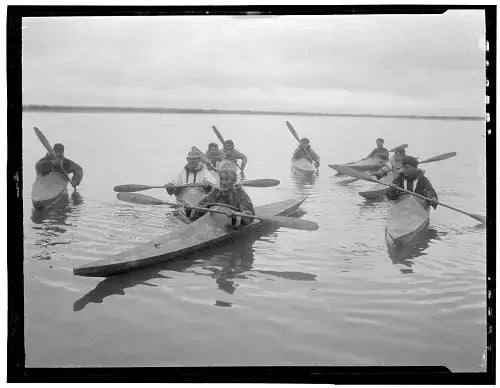Every wonder where the kayak came from? The kayak has roots that reach back into antiquity. These simple, sleek vessels have been plying the waters of the Arctic for at least 5,000 years and some say much longer. So how have they evolved (or not) over the centuries?
Ancient Origins of Kayaking
The Inuit and Aleut tribes are credited with creating the first kayaks. As one of a number of “skin boats” developed by these peoples, the kayak was intended to be paddled by one person with a double-sided paddle. That is mostly unchanged even today.
Skin boats were made by stretching the hide of a seal or walrus over a lightweight frame made of whalebone or driftwood and coated in oil for water resistance. A kayak in particular was a skin boat designed with a light hull, fully-enclosed cockpit, and a shallow base. This made these boats speedy, sturdy, and easy to maneuver—the perfect “hunter’ boat”, which is what kayak literally means.
The first kayaks were designed and used for hunting. In the frigid Arctic region, survival depended on the ability to get food. Since there were so few sources of food, indigenous people needed to rely on the sea for the largest, most sustainable source of protein. A sturdy, nimble boat was essential for a successful hunt and, ultimately, survival.
The kayak was created to do everything an Intuit or Aleut hunter needed.
- Small - This craft was designed to hold just one hunter who could maneuver it on his/her own.
- Lightweight / waterproof - The lightweight frame ensured that it could be dragged out of the water or onto the ice while still carrying a significant load. The elastic skin was able to absorb shocks from collisions. Most skins and seams were coated with blubber / oils / fats to prevent water from swamping the boat. This waterproofing had to be maintained constantly as it was a matter of life or death to stay out of the freezing water.
- Covered - the hull was completely enclosed except for a hole for the paddler to enter the craft. This design protected the hunter from the elements. (They even used the equivalent of a modern-day spray skirt, called an “annaraaq”, a jacket that covered the paddler to keep out water and protect). The covered hull was also used for tying down the day's catch and holding weapons (predominantly darts and harpoons), like modern-day bungees.
- Stealthy & agile - Of utmost importance, of course, was the ability of this vessel to get to the prey. Kayaks were designed to be stealthy and agile. A hunter could achieve speed quickly and get close to their kill. Another key life-saving aspect of this little boat was its ability to roll. Falling in the water was a death sentence and getting out and back into a boat was nearly impossible in those temperatures. The hunter in a kayak, however, was able to capsize but then roll themselves back to upright. The “eskimo roll”, seen even today, was a life-saving technique of these ingenious boats.
Almost all the things that made this boat popular with ancient tribes are still part of the appeal of kayaks today.
Modern Growth of Kayaking
In the modern age, kayaks arrived in Europe during the mid-nineteenth century. Largely in Germany and France, this soft-sided boat became a popular water sport for many paddlers. It continued to spread into England, the United States, and around the globe.
Over the next decades, kayaking gained a footing in the sporting world, even as it was still used for its traditional purpose in arctic waters. The kayak first appeared in the Olympics during the 1936 Berlin Games in Germany. The kayak races were a great hit with the public.
While the classic kayak could hardly be improved upon, modern-day engineers made a few adjustments. The biggest adjustment was honing in on the ability to steer and track. Two developments, the skeg and the rudder, were developed by British and American designers respectively.
A few other improvements in safety and performance have also changed the traditional kayak. Of course, modern materials made for lots of options in manufacturing these boats from aluminum, to fiberglass, to plastic, and more. This also allowed for more possibilities in watertight hatches, deck rigging, adjustable seats, and adjustable foot pegs.
Kayaks have also been designed for more extreme sports than just flat-water. Modern kayaks can tackle whitewater, downriver, and more. Sit-on-top kayaks have opened up (sorry for the pun) new options for fishing, disabled paddlers, and newbies. It truly does seem that the kayak is for everyone.
Current Popularity of Kayaking
Kayaks continue to surge in popularity. This little boat with a storied history is still getting paddlers around safely, speedily, and stealthily. It is used for racing, whitewater, fishing, and just recreational or touring. It can entertain the whole family or support the solo paddler.
Kayaks are a great way to get out in nature, enjoy the water, and do it without breaking the bank. While kayaks aren’t cheap, it is nothing like the money you would shell out for a motorized boat. And they can be stored easier as well. In fact, apartment dwellers and small car drivers are still able to be kayakers, thanks to all the options available today from inflatable to foldable kayaks.
Kayaks are affordable, versatile, customizable, and storable. It is no wonder that more and more people are falling in love with the paddle life.
National Anthropological Archives

